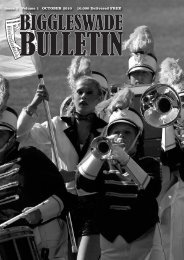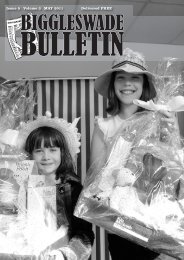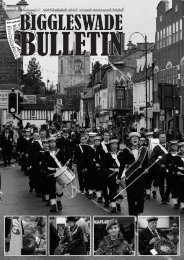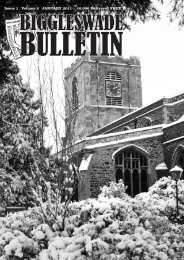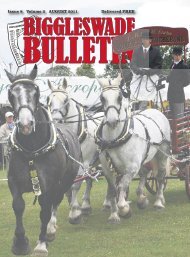BB_Sept 11.pdf - Biggleswade Rugby Club
BB_Sept 11.pdf - Biggleswade Rugby Club
BB_Sept 11.pdf - Biggleswade Rugby Club
Create successful ePaper yourself
Turn your PDF publications into a flip-book with our unique Google optimized e-Paper software.
22 BIGGLESWADE BULLETIN SEPTEMBER 2011 TEL: 01234 843905 EDITORIAL: editorial@biggleswadebulletin.co.ukAutumn wild foodsby Dean Cartwrightof Sylva Arborists.DEAN Cartwright has beeninvolved in Arboriculture andwoodland management since1997. Dean studied Conservationand Countryside Skills at CapelManor College, then worked as atree surgeon for a large contractorwhilst studying Arboriculture parttime. He worked for two years asan Arboricultural practical instructorand for the last seven years hasrun his own tree surgery companybased in <strong>Biggleswade</strong>, Beds andHerts. Dean’s company hasrebranded as Sylva Arborists.Each month Dean will be writingabout trees of interest and what tolook out for at this time of year.To contact Sylva Arborists call07937 574237 or 01767 313615 oremail treedoctor1980@ yahoo.co.uk. The website is at www.sustrees.co.ukAutumn Wild foodsIt is difficult to imagine lifeprior to imported foods that wenow take for granted as formingpart of our year round diet. Whenasked which foods provide vitaminC, most people would mentionTEL: 01234 843905 ADVERTISING: advertising@kempstoncalling.co.uk KEMPSTON CALLING SEPTEMBER 2011 41___________ I AM ___________THE ONLYTHINGATYOU’RELOOKINGRIGHTNOWI am the power of print. By picking up a magazine,you are investing your time and attention into seekinginformation. The printed media is an effective meansof engaging your potential customers.Call us now to find out how we can help you meetyour marketing targets. 01234 843905.oranges and other citrus fruits andtheir juices. When asked whichBritish foods provide vitamin C, itseems a challenge to come up witha dietary staple, save perhaps potatoes.Yet potatoes weren’t actuallyintroduced to Britain until around1590, and our ancestors beforethen did not all die of scurvybrought on my vitamin C deficiency.Their wild larder provided themwith any variety of fruits andberries that supplemented their dietwith the nutrients they needed. Inthis article I shall write about someseasonal wild foods that can befound, eaten and preserved around<strong>Biggleswade</strong> at this time of year.The most obvious autumn wildfood is surely the blackberry.There are domesticated speciesthat have been adapted to producelarger fruits and lose their thorns,but, as blackberry bushes, alsoknown as brambles grow so quicklyand can take over your gardenlike wild fire, I would favour plantingother fruits at home and do myblackberry picking on<strong>Biggleswade</strong> Common, in woodlandsand in hedgerows.Unripe blackberries start offgreen, then go red and finally blackonce they ripen. They may be largeron one bush, smaller on theneighbouring bush, sweeter, orjuicier on one bush than another.The variations to be discovered arepart of the fun of the autumn ritualof blackberrying. Blackberries canbe eaten fresh or made into jamsand jellies and used in pies, crumblesand many other deserts.Blackberries are notable for theirhigh nutritional contents of dietaryfiber, vitamin C, vitamin K, folicacid - a B vitamin, and the essentialmineral magnesium. Amongstfruit, blackberries rank highly forcancer-preventing anti-oxidantsand phytoestrogens.Sea BuckthornHippophae rhamnoidesSea buckthorn (pictured) is areal super food. It is a deciduouswoody shrub whose edible berriescontain one of the highest concentrationsof vitamin C of any plant:on average 15 times more vitaminC per weight than oranges. Seabuckthorn has rough brown orblack bark and a thick grayishgreencrown. It’s leaves are narrowand silvery, they alternate on thestem. In the autumn it producesdense clusters of orange berries.Although the plant is thawny, thisis one wild food I would definitelyrecommend planting in your garden.It makes a pretty ornamentalthat is good for wildlife, and willgrow in poor soils. Sea buckthorncan control soil erosion and waterloss effectively and it’s thornsmean it makes a good intruderproofhedge. You will need to plantboth a male and female shrub sothey can cross pollinate and produceberries. And with the berriesyou can make your very own nutritiousjellies, juices and syrups tosupply your family with vitaminsthrough the winter months. Seabuckthorn contains “flavonoids,omega 3 and 6, DHA and numeroustrace elements. […Also]arotenoids, vitamins B (FolicAcid), B1, B2, B6, B12, B15, K,amino acids, dietary minerals, -sitosterol and polyphenolicacids.Seabuckthorn naturally hasserotonin, a neurotransmitter thathelps to regulate emotions.”(http://seabuckthorn.co.uk/health.html)In addition to this, sea bucktornpreperations, when applied to theskin, are used around the world fortreating a wide range of skin disordersfrom burns and ulcers to dryskin conditions and the berries areused in sunblocks. For more informationon all aspects of sea buckthorncheck out www.seabuckthorn.co.uk/As with all wild foods makesure you consult a reliable identbook before indulging.Tree of the Month: WildService TreeThe wild service tree (Latinname Sorbus torminalis) is abroadleaf and one of our rarestnative British trees. It is also sometimesknown as the Chequers/Checkers tree and its fruit, whichwill soon be ripening and ready toeat is also called chequers.The wild service tree is rarelyfound in gardens and is a usefulindicator of native British woodlandsand hedgerows. It likes togrow in soils containing limestoneor clay. In the early 1990s it wasnoted that: “There are five WildService locations along the LowerGreensand ridge that runs fromsouth western Cambridgeshire toLeighton Buzzard inBedfordshire.” (1) The LowerGreensand Ridge, of course, runsthrough Sandy. We can see thetrees influence in the name ofnumerous Chequers Pubs andChequers Inns around Bedford -shire as well as the rest of the country.Ray Mears has described thewild service tree as a “woodsmanstree”. The leaves, similar to that ofa Maple leaf (think the Canadianflag), turn red in the autumn,resembling the flames of the firesthat traditionally kept us warmthrough the winter months. Theberries grow in clusters, starting offgreen in October and ripening to areddish brown. The taste is similarto dates or Medlars and likeMedlars the berries are best eatenafter the first frost once they haveContinued on next pagePhotographe by Hans Hillewaert



